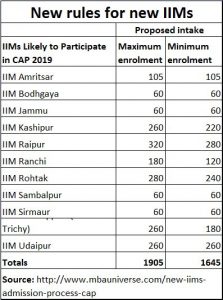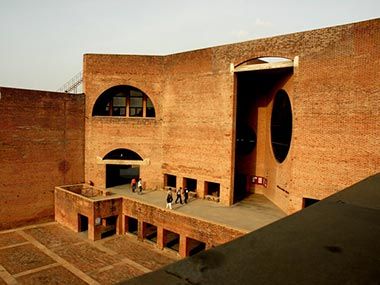https://www.firstpost.com/business/govt-should-stop-interfering-with-how-iims-should-be-run-better-focus-on-primary-secondary-education-5702601.html
Leave them IIMs alone . . . . .
RN Bhaskar Dec 10, 2018
There is good news and bad for the premier Indian Institutes of Management (IIMs).
The good news is that the government has allowed the IIMs to become independent in their recruitment processes. Last week, it allowed even corporate executives to apply for directorship of IIMs.
 But it will not be a simple entry for corporate honchos. The new rules, which have codified the terms and conditions of service of directors at all 20 IIMs, state: “The applicant shall be a distinguished academic with PhD or equivalent having at least fifteen years teaching or research experience and shall have worked as a full Professor at a reputed institution for at least seven years; or shall have industry experience at a higher level for at least fifteen years.” Thus even corporate executives will have to possess a PhD, though the teaching experience and full professorship for such executives may not be necessary.
But it will not be a simple entry for corporate honchos. The new rules, which have codified the terms and conditions of service of directors at all 20 IIMs, state: “The applicant shall be a distinguished academic with PhD or equivalent having at least fifteen years teaching or research experience and shall have worked as a full Professor at a reputed institution for at least seven years; or shall have industry experience at a higher level for at least fifteen years.” Thus even corporate executives will have to possess a PhD, though the teaching experience and full professorship for such executives may not be necessary.
The bad news is that the government still continues to lay down rules for the IIMs. Such rules ought to be framed by the IIT governing councils themselves. The institutes have proved their worth over the years, but just as the IITs have slipped in their global rankings, so have the IIMs. And the reason why they have slipped is because of the constant interference by the government into ways the IIMs are run, the manner in which recruitments take place, and even how the entrance tests are held.
History
It may be worth mentioning here that the first of the current 20 IIMs was set up at the instance of Jawaharlal Nehru on the recommendation of the Planning Commission. In 1959 it invited Professor George Robbins of the prestigious UCLA, USA, to help in setting up an All India Institute of Management Studies. It was on his recommendation that the government set up two elite management institutes at Calcutta and Ahmedabad. Both used the guidance of prestitious institutes overseas — MIT-Sloan School of Management, the Ford Foundation and the Harvard
Each IIM was registered as a society under the Indian Societies Registration Act and was meant to be autonomous and to exercise independent control over its day-to-day operations. But over the years, the administration and overall strategy of all IIMs is overseen by the IIM Council, headed by the Minister of Human Resources. In 1972, Ravi J Mathai recommended the setting up of two more IIMs at Bangalore and Lucknow. Thereafter, each government tried to set up more IIMs (see table).
Different processes
But the IIMs are not run along the same lines.
 Consider how the older IIMs enroll students based on their CAT (common aptitude test) performance. But the new IIMs are supposed to go through a CAP (common admission process).. If all IIMs have the same branding – expect for their location – why have different processes for one set of IIMs and another for a newer set? According to available data, around 2,000 students will go through the CAP, while the other 2,000 will appear for the CAT.
Consider how the older IIMs enroll students based on their CAT (common aptitude test) performance. But the new IIMs are supposed to go through a CAP (common admission process).. If all IIMs have the same branding – expect for their location – why have different processes for one set of IIMs and another for a newer set? According to available data, around 2,000 students will go through the CAP, while the other 2,000 will appear for the CAT.
That raises another fundamental question. Should all new institutes be called IIMs? True, every state wants an IIM. That would also be true in countries like the US where every state may want a Harvard or a Yale. But the answer does not lie in creating 20 harvards or MITs. Extending brands, and creating parallel products under the same brand invariably dilutes branding and quality control. This is something the government has not learnt till now. Even the present government has been responsible for setting up new IIMs in different states (see table 1). It may be beter to let them have a different name, with a different management structure. Leave it to the existing IIMs to decide whether they should be adopted under the IIM brand.
Third, the government still has a penchant of trying to persuade the IITs and the IIMs to lower the bar for enrolments for special categories. When educational institutions are vying to become centres of excellence, why resort to populism? Populist measures eventually ends up in lowering the standards of excellence, even education.
Another sore point with centres of excellence – including IIMs – is the government’s reluctance to give them total autonomy over finances. The concept of letting educational institutes build their own corpus appears to be anathema to babus and legislators. But if institutions are autonomous, they should also be allowed to plan for the perquisites they wish to offer to key staff, and the capital expenditure they wish to incur. Thus, the moment the instutiton makes a surplus, there is clamour for reducing fees. How much an institute charges should not be the government’s concern. If it wants needy students to be subsidised, it can either set up a scholarship, or mandate that 10% of the seats must be given to the needy at say one-fourth the average fees. Leave the fee charging to educational administrators.
Linked to this is the need for the government to create the required enabling set of laws that allow IIMs and IITs and other educational institutions to charge differential fees from foreign students. An Indian studying overseas invariably pays higher fees than what local students pay. Why should India have different rules?
It would appear that even though the government wants corporate executives to be considered for the post of directors in premier educational institutions, and even though it appears to promote autonomy for such institutions, the desire to retain control, and pull the strings is still there.
As long as strings are sought to be pulled, it won’t be long before the strings become ropes, and educational institutions either trip or die by this rope.
True, the government needs to do more for education. But it should first focus on primary and secondary education, which is a constitutional requirement. Having let this sector decay and crumble, it is dangerous to trust the same government with higher education.
The sooner the government learns to stay away from it, the better.










































COMMENTS